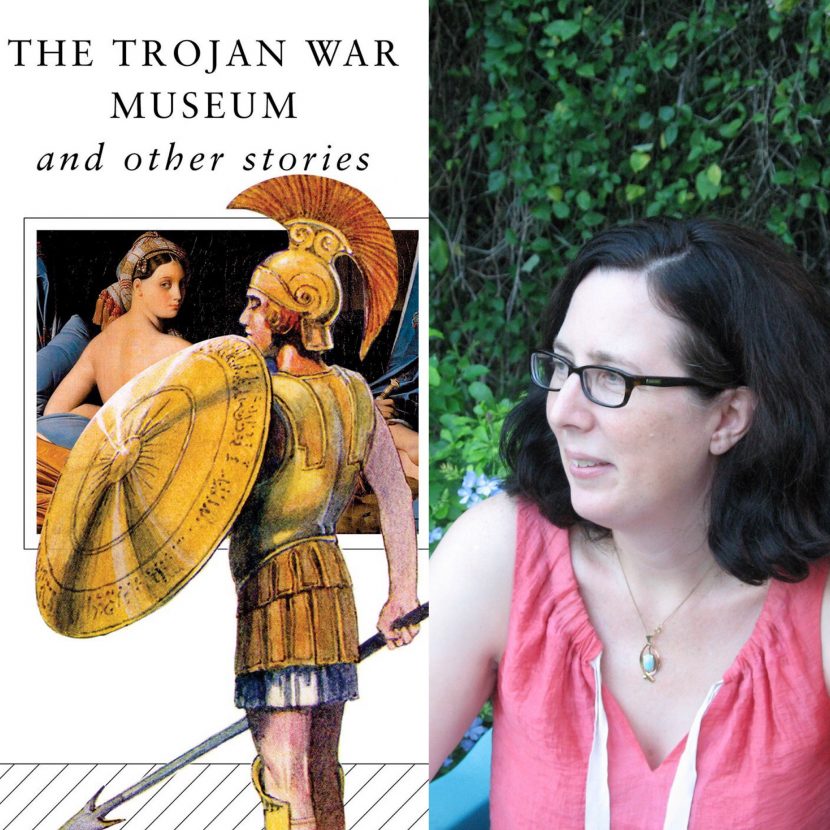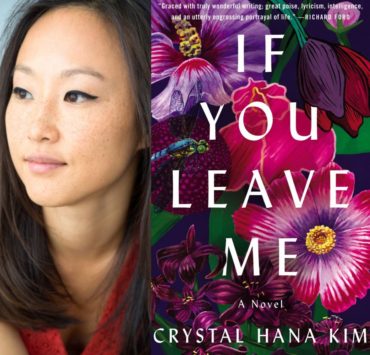
Bucak’s wry humor and easy storyteller’s voice persists throughout her collection, The Trojan War Museum and Other Stories. It is so easy to listen to her prose, to hear the stories her narrators tell, that occasionally you can feel stunned by their brutality.
“The Dead” traces the sponge-diving industry that killed thousands of Greek divers beginning in the nineteenth century. “The Trojan War Museum” imagines the institution of its title through millenium after war-filled millenium. “The History of Girls” is narrated by a group of girls buried beneath rubble by an earthquake. Bucak does not shy from this violence but tells it plainly, without any maudlin sentimentality. But she also spins a beautifully complicated, interracial love story in “Mysteries of the Mountain South,” and invents a chess-playing automaton capable of incredible passion in “The Gathering of Desire.” Each world is singular, and each feels fully explored. I interviewed Ayşe about The Trojan War Museum via email in August. Find our exchange below, lightly edited for length and clarity.
JG: First off: congratulations! The Trojan War Museum is so beautiful and it’s been getting deservedly rave reviews! How do you feel? Have you been enjoying the journey of publishing?
APB: Thank you, on the one hand, it’s been a very positive experience and I feel happy and proud, on the other, life never stops and nothing is simple, right?
I find publishing fascinating and I’ve enjoyed being behind the scenes. I’m fortunate that my agent, Julie Barer, my editor, Alane Salierno Mason, and my publicist, Erin Sinesky Lovett, have all worked hard to get my book into the hands of people who might appreciate it. Not once have they tried to market the book as anything other than what it is. When you write short stories you hear a lot of doomsday scenarios about publishing, but I have felt really embraced.
All that said, one of the constant challenges of writing, for me, has been how to be ambitious and yet still happy and occasionally satisfied. Small goals and the celebration of achieving those goals helps, but I tend to be looking at the next thing a lot. Which maybe is healthy, who knows?
To further complicate things, my father was diagnosed with a terminal illness not that long after the book sold—so all the pleasures ran parallel to a lot of personal sadness. But I think that helped keep everything in perspective. The book was something for my family to be happy about, and helping take care of my father was something to remind me that the book is ultimately a pretty small thing.
JG: I notice that, in previous interviews around some of these stories, you discuss the larger mythologies that are present in your work in context of your personal experience—going to see Prometheus Bound at the Philadelphia Museum of Art, spending time on the Aegean coast, etc. How do you think some of those early experiences helped to shape your sense of history and mythology? Their scope and possibility?
APB: I think the common denominator in the things I was drawn to as a kid and the things I am drawn to now is the feeling of seeing the world as more magic and unexpected than it seems. One of my students once said every story is Where the Wild Things Are. I kind of love that as an idea. While it may be be an overstatement to say “every story,” I do think a lot of stories are basically engaged with the hope that our bedrooms will transform into magical jungles. When I look at art, or when I travel, or when I read history, or myth, I tend to experience that transformation—suddenly that which seemed ordinary is not. I think that’s what I’m trying to recreate in a lot of these stories.
JG: We’re kind of demanding with that childlike expectation, aren’t we? That a story might open up a portal to somewhere else? Are storytellers just people who can find the portal from ordinary to extraordinary?
APB: I don’t think it’s only that, but I like that way of looking at it. I think a lot of creative writing pedagogy focuses on conflict and tension as if those are the only ways to hold a reader’s interest. The sublime, the fantastic, those are also great ways to hold a reader’s interest. And they don’t have to be wrapped up entirely in conflict.
JG: These stories remind me of Yiyun Li’s short work, in that they are so big, they open the form up like air in a balloon. You’ve talked before about learning to take your time with stories by writing a now-drawered novel. You’ve also said this book took ten years to write. Do you envision these stories being so big and mythic? Or is there something in taking that time that feels necessary to writing this way?
ABP: I needed to take my time with each story because I’m simply not smart enough to come up with ideas (or plots) quickly. I had the goal of building a lot of layers into each story and in a bunch of cases it took research and brainstorming time and waiting for the right idea in order to get to the point where I felt the layers made sense together and did enough work. I think being patient with these stories let them get more complicated—at least I hope so.
JG: You are a writer who loves research! I, also, love a deep dive into the archive, not least because there’s always something surprising in it. What is the most unexpected thing to have ever jumped out of your research, whether it’s related to your writing or not?
APB: Every single thing I learned about sponge diving was a surprise. (Yes, I did a “deep dive” into diving.) One of the stories is centered on a sponge merchant in Key West, and having visited Key West, I thought I had more than the average person’s knowledge of sponges—but I had no idea. First of all, sponges are living creatures that are essentially beaten to death. Second of all, sponge diving was a huge industry, a massive money-maker during the Industrial Revolution (sponges were good for cleaning machines). And most significantly, thousands and thousands of Greek divers died or were permanently disabled while diving—because they were pushed to go down too often and too fast. One expects certain industries to be dangerous—coal miners going underground, for example—but I had no idea that sponge diving was one of the cruelest, greediest industries in history.
JG: I love that piece (“The Dead”) for the reason that the story connects continents through immigration, but also by the dreadful consequences of the sponge diving industry that, as you say, was a globally-interconnected phenomenon. Do you see particular ways that movement and commodification go together or are caused by each other?
APB: I suspect yes, but I feel in no way qualified to really answer. One advantage of being a fiction writer is I can observe patterns of behavior in history and then reproduce them in my fiction to call a reader’s attention to them, but I don’t have to be set on what they mean. I just have to know they happened. I will say the sponge-diving industries in Key West and on the Gulf Coast of Florida were less harmful than the Ottoman/Greek industry was. Hopefully some lessons were learned.
JG: Your narrators are not afraid of a direct address, and many of your stories end with some sort of statement that turns the focus, through a “you” or more subtly, onto the reader. How do you see the role of this direct address in your stories?
APB: It helps me to think that a person is telling the story even if it seems like a third person story. Stylistically, it gets me thinking about sound, and about putting some personality to the narration. Thematically, it reminds me that no narration is neutral or objective, and that I should consider the agenda of the storyteller even in a third person story. I also tend to like how the shift to direct address can draw the reader in a little closer when you’re working with a story that is largely told through exposition. In fact it can be way more intimate than scene.
JG: “A Cautionary Tale” employs brief sections of an unnamed interviewer and interviewee, interspersed between the story of Yusuf Ismail, legendary Turkish wrestler who was “imported,” in your narrator’s verbage, to Western Europe, then the U.S. These interview sections become more contentious as the story progresses, feeling by the end like an interrogation. It has the feeling of a border official withholding a passport stamp until threatened with legal action. Is the cautionary tale really for readers here? That the story we know may not be the story?
APB: The interview style of this story was inspired by the young adult novel I am the Cheese by Robert Cormier. There’s an interviewer/interviewee format to much of the novel that I found hugely So I wanted to try it. On the simplest level, the border agent (as I imagine him) is offering the interviewee a cautionary tale about leaving home. And while I view the interviewer as a fairly negative force, trying to control things he shouldn’t, I wrote the story out of the ambivalence that I know my father felt about having immigrated to the United States. He never really knew if he wanted to be here or there. I worry now about how this story will be read in an unnuanced world that doesn’t necessarily have room for the idea that immigration doesn’t always work out. But it doesn’t always work out. (That doesn’t mean it shouldn’t be allowed, of course.)
JG: This reminds me a bit of Proust’s quip about a fashionable milieu being one in which everybody has the same opinion, while a literary milieu is one in which everybody has a different opinion. Do you think stories resist easy explanations or political orthodoxies simply by their insistence on complication—on what is/was, rather than what “should” be?
APB: I think a lot of great stories do. But I also find a lot of great stories are actually straightforward in their ethical and/or political stance. “History of Girls” is a very simple story that at its core is saying girls need to be valued more than they are. That unnuanced point is one that still needs to be made. And it seems to be one of my most popular stories.
JG: “The Trojan War Museum” is playing with some heavy mythology and well-trodden fictional ground, but it still feels so fresh. I think part of the reason for this is that it covers so much war, so much history, and so much of the violence since Troy, that even the gods are exhausted by it. It ends on a note of cautious hope, that perhaps there is an After War to be found. Perhaps I betray some cynicism by asking this, but am I reading that right? Do you see that as a real possibility?
APB: I think most of my stories actually end on a small bit of optimism. What else have we got? Do I think war will go extinct—no, not likely. But chasing impossible dreams can still have benefits. Writers know that well, I think.
The ending originally read “The After War instead of the Ever After War. The true Trojan War Museum. What are the odds? Who knows? Now there are buttercups upon the Trojan plain,” but I took out the “who knows,” which maybe makes the optimism feel more definitive. I wish I’d left it in there, to be honest. I mean, really, who knows?
JG: I mean, I certainly don’t know. But an end to war is not even imaginable for some folks, right? Is that perhaps some of the role of the storyteller? To examine what is imaginable rather than simply what is possible?
APB: Definitely. One of the teaching sound bites I like to feed my students is: research the past, observe the present, imagine the future.
JG: There are many references throughout the book to jinn and other spirits, often in connection with storytelling. Can I ask you to broadly explain why you were interested in the spiritual realm for this book?
APB: I am not a religious person, but I think the “spiritual realm” is a real part of human experience, and so it seemed impossible to ignore it. But I also think it’s a good tool for revealing interiority. When one character talks to the jinn on her right shoulder and the jinn on her left, she is giving the reader access to the drama in her mind.
JG: You write a lot on writing and teaching, but I’m interested here in your advice on a slightly different subject. What is your best advice for readers in 2019?
APB: I love this question. I think sometime readers get caught up in trying to duplicate a reading experience that they already had. They say I loved “x,” what book is most like “x”? But it’s very hard to duplicate an amazing reading experience. Instead I recommend readers seek out new reading experiences. The library is a great resource for sampling things that you have no idea if you’ll like or not. I am all for an open borders imagination. Try everything, and if you don’t like it, move on to something else.
Ayşe Papatya Bucak teaches in the MFA program at Florida Atlantic University. Her prose has been published in a variety of magazines, including Kenyon Review, Prairie Schooner, Creative Nonfiction, Brevity, and The Rumpus. Her short fiction has been selected for the O. Henry and Pushcart Prizes. She is a contributing editor for the literary journal Copper Nickel.
The Trojan War Museum and Other Stories is available for purchase here. Read Ayşe Papatya Bucak’s “The History of Girls” now, on Aster(ix).

Joshua Graber is a Pittsburgh-based writer, translator, and educator. His fiction has appeared in Glimmer Train, The New Guard Review’s BANG!, and Map Literary. He is an MFA candidate at the University of Pittsburgh.







